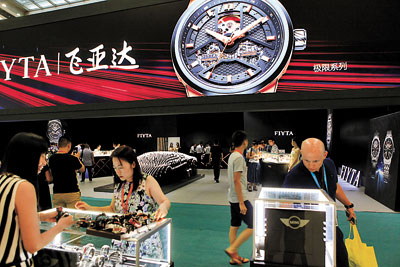|

Liu Minxia
mllmx@msn.com
INDICATING a trend in the watchmaking sector, Shenzhen’s annual Watch and Clock Fair dedicated a whole exhibition hall this year to wearable products brought by high-tech giants such as Huawei Technologies and Lenovo.
However, some traditional watchmakers, from home and abroad, believe that traditional watches won’t be replaced by wearable products because of their time-honored craftwork and will remain a thriving industry for decades to come.
At Hall 9 of the 26th China Watch & Clock Fair, the largest of its kind in the country and the third-largest in the world, Huawei, Lenovo, ZTE Corp., Inwatch, Tianba and other Chinese firms showed their latest wearable products. In previous years, the hall was designated to show the core technology of watchmaking: movements.
In addition to exhibitors, a large proportion of buyers visiting the fair, which closed yesterday, were wearable device manufacturers that were purchasing watch parts for their products or were in search of traditional watchmakers to help develop wearable products, according to Zhu Shunhua, head of the Shenzhen Watch & Clock Association.
Some traditional watchmakers, however, have not embraced wearable technology. A leader of China’s clock manufacturers, FIYTA (Group) Holdings unveiled several new models under three brands of the Shenzhen-based watchmaker — all of which were traditional watches.
FIYTA acquired Beijing Watch Factory earlier this month in hopes of expanding in the traditional watch sector.
“As China’s GDP grows, watches are becoming more of an ornament and a status symbol to Chinese,” said Du Xi, vice general manager of FIYTA. “U.S. consumers wearing a watch on their wrist are about six to eight times those in China, so there is still a large growth potential for watchmakers.”
Du believes wearable products, which are becoming more affordable and emphasize practicality, won’t replace traditional watches even in the future, as the latter is a time-honored craftwork.
Echoing Du’s judgment, most foreign watchmakers at the fair showed only traditional watches.
Ten French watchmakers exhibited as a group at the fair. In addition to traditional watch models, they also brought antique clocks to emphasize their timepiece culture. The Russian Clock and Watch Association brought four brands while Swiss watchmakers brought their latest designs of traditional watches that better meet young consumers’ demands. German watchmakers, wooed at last year’s fair, brought eight of the most popular German watch brands to the fair.
On the sideline of the fair, a watch design competition was held to help the wearable device sector to grow. Winners were hoping to obtain a fraction of the 700 million yuan (US$114 million) in investments that were up for grabs.
|

